Exploring The Legend of Zelda: Wind Waker for GameCube
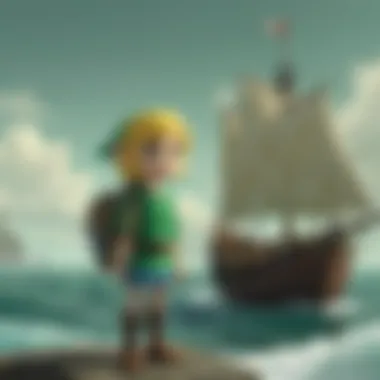
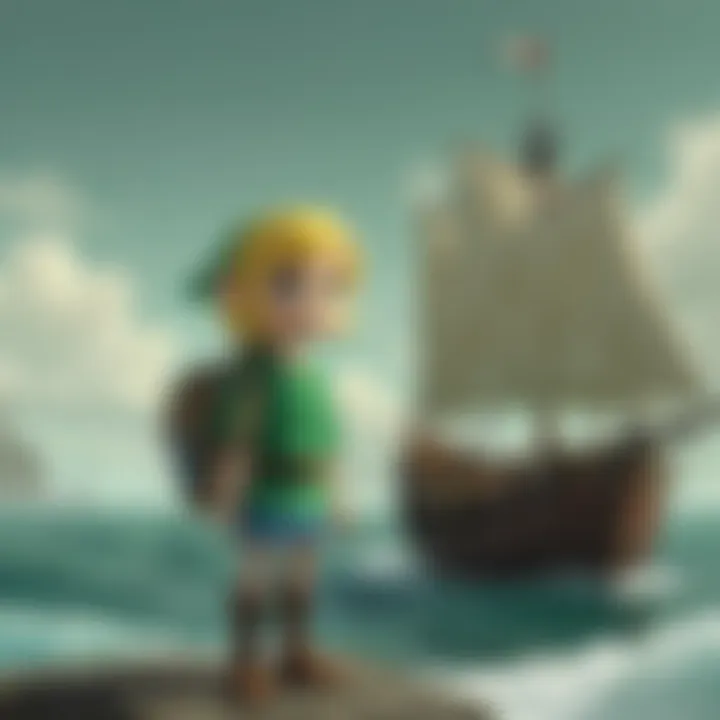
Intro
The Legend of Zelda: Wind Waker invites players into a vibrant, oceanic realm filled with adventure, mystery, and charm. Released on the GameCube in 2002, this title marked a significant pivot in the Zelda series' artistic direction and storytelling. Many fans were taken aback by its cel-shaded graphics which, unlike the more realistic styles of previous installments, delivered a fresh and whimsical visual experience. The game not only stands out because of its unique art style but also for its intricate narrative, rich lore, and engaging gameplay mechanics.
The immense sea serves as a backdrop for Link's quest to rescue his sister and thwart the nefarious plans of the evil Ganon. Wind Waker breaks different kind of grounds, forging a strong identity among Zelda titles and setting the stage for further exploration of this beloved franchise. In the sections to follow, we shall dive into gameplay reviews, character dynamics, detailed lore discussions, and effective strategies for players.
Game Reviews
Gameplay Features and Mechanics
Wind Waker introduced players to a refreshing sense of freedom rarely seen in previous installments. The vast ocean is dotted with islands, each offering unique challenges, puzzles, and secrets to uncover. Sailors can navigate using the King of Red Lions boat, making travel an adventure in itself. The mechanics also diverge from the familiar dungeon crawl - puzzles and combat challenges are integrated into the environment more organically, promoting exploration.
"The mere act of sailing becomes synonymous with discovery in Wind Waker, each wave suggesting untold narratives waiting beneath the surface."
Players employ the Wind Waker baton to manipulate wind direction, which is vital for efficient sailing. This mechanic not only adds a layer of strategy but also emphasizes the element of time management. In a world where water dominates, mastering the winds is akin to mastering fate.
Storyline and Quests
At the core of Wind Waker lies a narrative that resonates with themes of heroism, family, and the passage of time. Link, a young boy adorned in green, embarks on a hero's journey that resonates deeply with players. His goal: to rescue his kidnapped sister, Aryll, and confront the looming specter of Ganon. As players traverse the seas and islands, they encounter various quests, each interwoven with lore and the overarching narrative.
The inclusion of side quests further enriches the player's experience, from treasure hunts to helping villagers. Each completed quest offers not just rewards but deepens the connection to the world and its inhabitants.
Visuals and Sound Design
Visually speaking, Wind Waker is a masterpiece of art direction. The cel-shaded graphics create a dreamlike environment, where shades of blue, green, and gold dance across the screen. The artistic choices transcend mere graphic capabilities, offering an emotional texture that resonates with the gameplay.
Sound design plays an equally crucial role in immersion. The haunting melodies paired with the sounds of the sea create an atmosphere that wraps around players, making the experience not just visual, but auditory. Each dungeon, village, and battle is punctuated with compositions that etch memories into the player's mind.
Comparison with Previous Titles
Wind Waker's departure from the realistic graphics of titles like Ocarina of Time or Majora’s Mask was a double-edged sword at its launch. While some welcomed this breath of fresh air, others missed the darker tones and intricate details of its predecessors. However, as time has shown, Wind Waker holds its own, offering a compelling narrative and gameplay mechanics that stand the test of time.
In retrospect, Wind Waker’s brave artistic choices helped redefine expectations within the franchise. It juxtaposes its predecessors not as lesser titles but as stepping stones that have broadened what the Zelda series can be.
Character Analyses
Popular Characters Overview
Characters like Link, Zelda, and Ganon are apparent, but Wind Waker introduces a wealth of secondary figures that add depth to its narrative. Tetra, the pirate princess, stands out as a particularly strong character whose playful defiance complements Link's earnestness. The King of Red Lions, a sentient boat, serves not only as a vessel but also as a mentor figure, grounding Link's quest with wisdom and history.
Character Development and Backstories
Link’s evolution in Wind Waker is noteworthy, as he transitions from a naive boy to a seasoned hero with a deeper understanding of his role. Tetra's character arc is especially significant, revealing her true identity as Princess Zelda and exploring the complexities of her leadership and bravery. Each character, however trivial they may seem, has horns, layers, and motivations that are deserving of attention.
Role in the Zelda Universe
Wind Waker expands the lore of the Zelda universe, introducing new timelines and character depths that resonate throughout later titles. The very nature of heroes and villains is explored through the relationships present in the game. The layers of complexity in Tetra and Link's relationship demonstrate the nuances that shape their destinies, unlike simplistic rivalries or alliances seen in earlier titles.
Fan Theories and Speculations
The community surrounding Wind Waker is vibrant, often buzzing with fan theories and discussions. Some speculate on the implications of its placement within the Zelda timeline, while others delve into the ethereal nature of the Triforce and its symbolic representation. Each theory adds another layer of engagement for dedicated fans, enriching their experience well beyond gameplay.
Lore Discussions
Mythology and Worldbuilding
The lore of Wind Waker draws upon a blend of mythologies, particularly through its immersion in a water-centric world. The Great Flood serves as a critical narrative element, representing themes of rebirth and the consequences of past actions. This cyclical approach to storytelling offers players a rich tapestry of history to explore and engage with.
Legendary Items and Artifacts
Throughout Link’s journey, players encounter numerous artifacts and items that advance gameplay while deepening the lore. The Master Sword, the ultimate weapon against evil, is intrinsically linked to Link's fate and the history of Hyrule itself. The various treasures found across the islands serve not only as collectibles but as gateways into the past.
Link to Real-world Mythologies
Incorporating elements from various real-world mythologies, Wind Waker elicits parallels to concepts such as lost civilizations and the enduring nature of heroes. Players may draw comparisons to tales like Atlantis, where a once-glorious world now lies beneath the waves. This connection enriches the gameplay, engaging players imaginatively.
Timeline Placement and Theories
The intricacies of the Zelda timeline often lead to heated discussions among fans. Wind Waker occupies a unique position, set in a world altered by the events of its predecessors. Its placement introduces a narrative of consequences, probing deeper into what it means to be a hero in an ever-changing world.
Gameplay Strategies
Combat Techniques and Tips
Combat in Wind Waker requires finesse and strategy. Mastering parry attacks and combos can greatly enhance effectiveness in battles. Understanding enemy patterns can also hold the key to victory—study their movements before engaging.
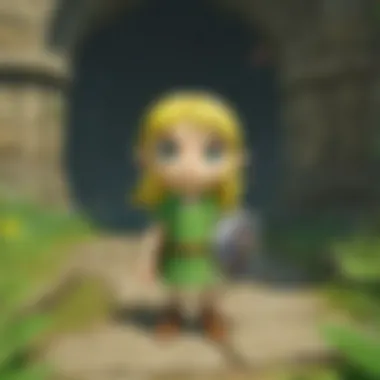
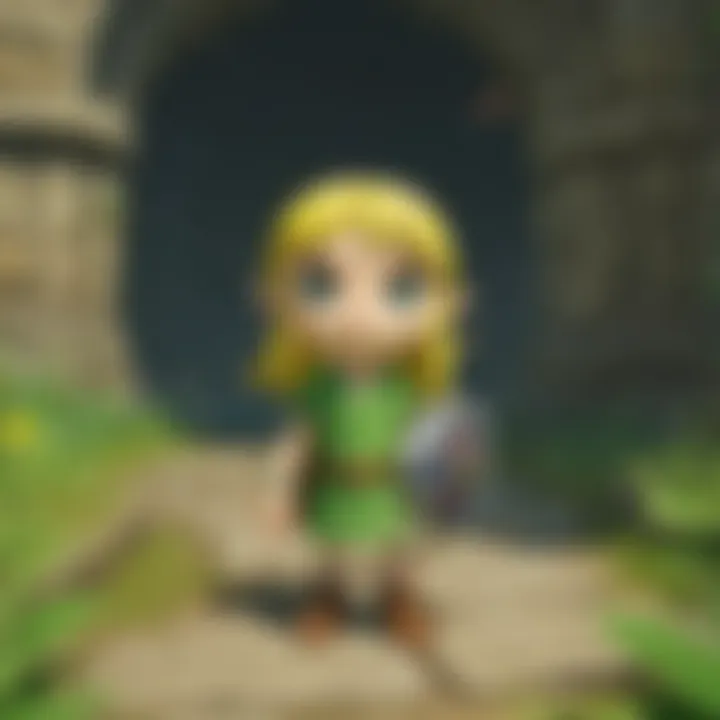
Puzzle Solutions and Walkthroughs
As players explore dungeons and islands, puzzles often present challenges that require keen observation. Utilizing items like the grappling hook or boomerang can solve many of the game’s riddles. Solution strategies generally invoke creativity, often demanding players to think outside the box.
Collectibles and Side Quest Guides
The world is filled with collectibles, such as hidden treasures and heart pieces. Engaging in side quests ties players more intimately to the rich lore and character backstories. Some guides suggest completionist approaches, offering tips on how to collect every item without getting bogged down in minutiae.
Boss Battles Tactics and Strategies
Confronting bosses in Wind Waker often requires players to utilize all skills mastered throughout the game. Observing weaknesses and employing strategic items can turn the tide of battle. For instance, using the boomerang to stun a foe before dealing deadly blows can create openings in challenging battles.
Through a blend of engaging storytelling, beautiful artistry, and robust gameplay mechanics, Wind Waker remains a standout entry in the Zelda franchise. It invites exploration and reflection, echoing themes of adventure and the quest for self-discovery through Link's odyssey across the perilous yet mesmerizing seas.
Prelude to Wind Waker
When one thinks of gaming milestones, The Legend of Zelda: Wind Waker stands tall among its peers. It’s more than just a game on the GameCube; it reshaped the landscape of adventure and storytelling within the industry. This section will unpack the significance of Wind Waker, diving into the impacts that make it a cornerstone in the long-standing Zelda franchise.
Overview of the Game
Released in 2002, Wind Waker transported players into a vibrant, cel-shaded world characterized by its unique art style and expansive oceanic landscapes. The game serves as a bridge between tradition and innovation, presenting familiar characters and themes while introducing new mechanics and a fresh aesthetic. Players assume the role of Link, a youth called to action amid an expansive world filled with mysteries and formidable foes. As Link ventures across islands, he navigates not just physical challenges but also the deeper emotional currents woven into the narrative.
The freedom of exploration, coupled with the magic of sailing across an endless sea, offers a unique experience. This adventure is not merely about combat but also about discovery and growth. The narrative encourages players to forge their own paths, reflect on choices, and unravel the deeper layers of lore. The innovation in design and storytelling makes this an essential chapter in gaming history, resonating with audiences both young and old.
Release and Reception
Upon its release, Wind Waker met with contrasting opinions, sparking debates among fans and critics alike. Some lauded its artistic direction, which was a significant departure from the realistic graphics of its predecessor, Ocarina of Time. The bold choice to embrace a cartoonish visual style, while polarizing at first, ultimately became a hallmark of the game, drawing admiration for its charm and timelessness.
Critics were quick to praise the game’s expansive world and engaging mechanics. The mix of exploration, questing, and puzzle-solving captured the essence of adventure. Despite some initial backlash regarding the aesthetics, the reception quickly turned positive, with many recognizing Wind Waker as an ambitious masterpiece that redefined an already acclaimed franchise.
Here are a few key points regarding its early reception:
- Sales Success: Wind Waker eventually sold over 4 million copies worldwide, marking it as one of the GameCube’s best-sellers.
- Awards: It secured several awards for its innovative design and artistic presentation, including recognitions in the categories of "Best Game" and "Best Artistic Direction".
- Cultural Impact: Despite the early hesitation, Wind Waker's aesthetic approach has heavily influenced numerous games since its release, demonstrating the importance of innovation in design.
In hindsight, Wind Waker's embrace of a distinct visual style has become a captivating element that continues to inspire new generations of game designers and artists.
In summary, the legacy of Wind Waker rests not just in its gameplay but in its willingness to take risks. By diving into both its overview and the immediate reception, we gain a clearer understanding of why it remains such a significant title within the Zelda series.
Artistic Design and Style
When considering The Legend of Zelda: Wind Waker, one cannot overlook the remarkable influence of its artistic design and style. The game’s aesthetics play a crucial role in shaping players' perceptions and experiences. Its unique art style is not just a visual treat; it deeply intertwines with gameplay and narrative elements, facilitating interactions and emotions that resonate long after the console is switched off.
Cel-Shading Technique
Cel-shading is an animation technique that simulates the painting style of cartoons. In Wind Waker, this technique transforms the game into a vibrant tableau reminiscent of animated films. Unlike traditional techniques that focus on realistic textures and shading, cel-shading commits to flat colors with outlines, creating a visually striking and cohesive world. This gives Wind Waker a timeless quality that hasn’t aged in the way many other 3D games have. It might seem almost like an old comic book brought to life, striking a balance between youthful whimsy and adventurous spirit.
One essential aspect of cel-shading in Wind Waker is how it invites players to engage more deeply with the game world. The bold colors and exaggerated character designs make it easier for players to immerse themselves in the narrative and environment. Moreover, the cartoon-like visuals help soften the darker themes of the story, such as loss and the search for identity. Instead of overwhelming players with desolation, the style allows these heavy themes to be handled with grace, providing a platform for exploration and wonder.
In practical terms, cel-shading also impacts the technical side of gameplay. By allowing simpler models and fewer textures than traditionally rendered environments, developers could create more extensive and varied landscapes. These sprawling ocean vistas not only highlight the world’s scale but also enrich the gameplay experience as players venture through vast islands discovering hidden treasures.
Visual Influence and Legacy
The visual influence of Wind Waker is undeniably significant. When it was released in 2002, it sparked debates in the gaming community about the suitability of a cel-shaded aesthetic in more serious games. While some viewed the style as juvenile, others praised it for its boldness and creativity, setting a precedent for future titles. Rather than sticking to the gritty realism that became popular in the early 2000s, Wind Waker forged its path, proving that games can embrace a more artistic approach.
Subsequent releases in the Zelda series have occasionally echoed this decision, blending focus on artistic integrity with gameplay mechanics. Titles like Hyrule Warriors and The Legend of Zelda: Breath of the Wild have taken notes from Wind Waker’s style, introducing vibrant colors and less serious character designs while still delivering rich and intricate storylines.
In a broader context, Wind Waker’s approach to design resonated across the entire gaming landscape. Developers began to explore innovative stylistic choices, leading to works like Borderlands and Four Swords Adventures, which harnessed similar aesthetic principles to evoke unique experiences. Perhaps more importantly, its legacy can be seen in how games consider visual style as a narrative device, inviting players to engage in a world that conveys both atmosphere and story through artistry.
"Wind Waker proves that gameplay and art style can dance hand in hand, creating experiences that are not just played, but felt."
In summary, the artistic design and style of Wind Waker set a high bar. Its cel-shading technique provides a foundation not only for visual identity but for emotional engagement within the game. The influence it cast upon subsequent titles reinforces the idea that aesthetics matter — and that they can hold powerful secrets waiting to be unlocked by the players brave enough to sail the seas.
Characters in Wind Waker
The characters in The Legend of Zelda: Wind Waker are not mere avatars moving through the game's beautifully crafted landscapes; they are the heart and soul of the narrative. Each character brings forth unique motivations and traits that shape the gameplay experience and the overarching story. In the grander scheme, their interactions lay the groundwork for the emotional depth that resonates with players, effectively turning an action-adventure game into an epic tale of courage, friendship, and the self-discovery of heroism.
Link: The Hero of Winds
Link serves as the player's conduit into the vivid world of Wind Waker. Unlike his predecessors, Link in this iteration is portrayed as a more youthful and innocent figure, wearing his trademark green tunic with uncovered joy and bravery. The choice of a young hero signifies that the quest for adventure sometimes starts from the simplest of beginnings.
This approach does wonders in terms of relatability, especially for younger players who might see themselves in Link's shoes, sailing across the seas and facing challenges head-on. As he journeys through the game, players watch as Link evolves from a timid boy into the confident "Hero of Winds."
"Link's growth throughout the game is marked not just by his fighting prowess, but by his ability to form bonds with others, lengthening his journey beyond mere questing."
From acquiring his iconic sword, the Master Sword, to mastering wind magic, Link's adventures are richly layered with gameplay mechanics that make him feel dynamically engaging. The balance of exploration, combat, and puzzle-solving reinforces his role not just as a hero, but as a well-rounded character who faces struggles, learns from them, and ultimately overcomes adversity.
Zelda's Role and Representation

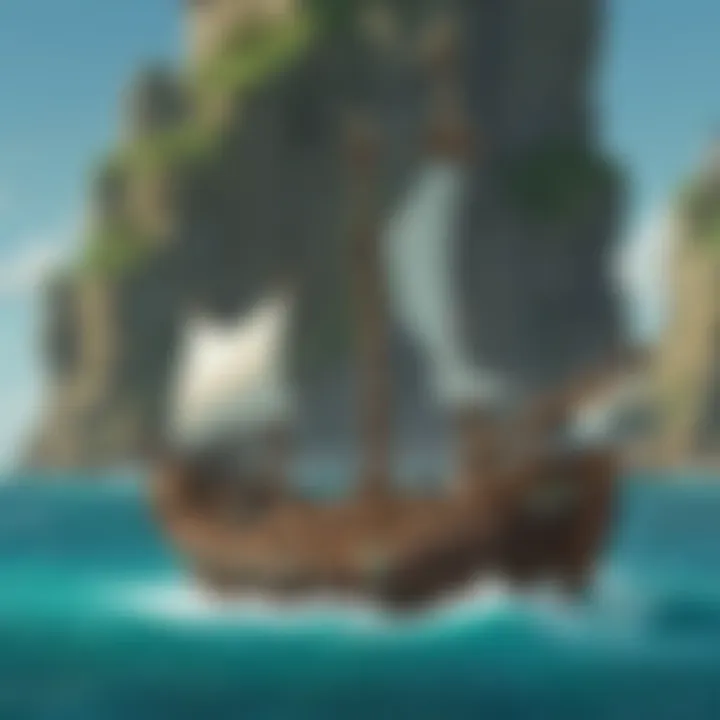
Princess Zelda has always been a defining figure in the Zelda series, and Wind Waker does her exquisite justice. Rather than being relegated to a damsel in distress, she is integral to the narrative and embodies the themes of courage and wisdom. Through the guise of Tetra, Zelda takes on a fiesty persona that contrasts with her royal lineage.
This duality adds complexity to her character. As Tetra, she is proactive, headstrong, and unafraid to get her hands dirty. This not only enhances her relationship with Link, but also allows her to reflect the game's maritime themes of adventure and exploration. The revelation of her true identity is a significant moment that deepens the plot and showcases her resilience.
Moreover, Zelda's character encourages players to rethink traditional gender roles in gaming. She stands as a capable fighter, making decisions independently, and supports Link throughout their perilous journey, proving that her role is far more than just a supporting character.
Antagonists: Ganon and Others
Every great hero needs an equally compelling foe, and Ganon fits that bill perfectly in Wind Waker. Unlike his previous incarnations, Ganon is depicted with a fresh perspective, blending an effective blend of menace and charisma. His ambitions to capture the Triforce and reign over the world inject tension and urgency into the narrative.
Other adversaries, like Manga, further enrich the antagonist pool. They are more than just roadblocks for Link; they embody the game's thematic discussions, particularly around greed and lust for power. Each encounter with these villains emphasizes the moral struggles and dilemmas faced throughout the adventure.
The dynamic nature of these characters—where their motivations reflect deeper societal issues—positions Wind Waker not just as another game, but as a nuanced commentary on the consequences of power.
Gameplay Mechanics
In examining The Legend of Zelda: Wind Waker, the gameplay mechanics serve as the backbone of the experience, drawing players into its vibrant world. These intricacies are not merely functional; they define how one engages with the game’s narrative and environment. The blend of different mechanics—exploration, combat, and puzzle-solving—creates a fluid and engaging experience that propels players through the high seas of Hyrule.
Exploration and Open World
At the heart of Wind Waker lies its vast and boundless ocean, which offers a refreshing take on exploration. The game utilizes a sailing mechanic where players navigate a sailboat called the King of Red Lions, crossing islands scattered across a limitless ocean. This mode of transport makes seafaring not just a means of travel, but an adventure in itself. Players experience the thrill of the unknown as they glide over the waves, charting their course through discovery.
Moreover, the islands are filled with distinct ecosystems, quests, and secrets, inviting players to explore at their own leisure. From Outset Island to Tingle Island, each location brims with unique encounters, treasures, and lore that contribute to the world-building. The treasure maps, hidden caves, and ruins beckon the explorer in everyone, proving that the adventure is as much about the journey as it is about the destination. Players are often rewarded for their curiosity, which emphasizes the importance of exploration as a fundamental part of gameplay.
Combat System
Combat in Wind Waker is a dynamic and engaging affair. The game employs a free-form combat system that allows Link to perform various moves, including slashes, dodges, and parries. This creates a responsive battle experience, unlike more rigid systems found in other titles. Here, timing and positioning play crucial roles, as players must learn to anticipate enemy moves and react accordingly.
Several enemy types add to the challenge, each requiring different strategies to defeat. For instance:
- Moblin: Straightforward brute, but can be outmaneuvered with clever dodging.
- ChuChu: Adapts its attack based on its environment, urging players to think outside the box.
- Stalfos: Demands quick reflexes and mastery of parries to fend off their relentless assaults.
This combat versatility is complemented by the acquisition of various weapons throughout the game. From swords to bows, the choices available imbue each encounter with potential for genuine creativity. Players can feel the weight of their actions as combat evolves with the challenges presented, ensuring it remains engaging throughout.
Puzzle Solving and Dungeons
Puzzle-solving is another key aspect of Wind Waker's gameplay mechanics, which often intertwines with exploration and combat. The game’s dungeons are rich with challenging puzzles that require thoughtful approaches and keen observation. Each dungeon typically introduces unique mechanics that challenge the player’s ingenuity.
Take for instance the Forsaken Fortress, relatively early in the game, which features stealth elements combined with intricate puzzles. Here, players must utilize the light from Danny's lantern to uncover hidden pathways and navigate through its shadowy halls. These puzzles not only enhance the challenge but also deepen the immersion, intertwining narrative elements and gameplay in a thrilling manner.
Moreover, dungeon design incorporates environmental manipulation, such as moving blocks or activating switches, to unlock new areas. Each victory feels earned, as players must use the tools at their disposal—often items previously gathered on their journey—to progress. The satisfaction of piecing together a puzzle or defeating a particularly tricky opponent fosters a sense of accomplishment that keeps one hooked.
Wind Waker’s gameplay mechanics come together in a harmonious dance, offering players the agency to explore, combat, and solve puzzles at their own pace, while steering a narrative filled with rich lore. As a whole, these elements not only define the experience but elevate it into something memorable and engaging—making every moment in the game feel impactful.
"The Genius of Wind Waker lies in its balance, where each mechanic enhances the other to create a truly immersive adventure technique."
The seamless integration of mechanics, aesthetics, and storytelling sets Wind Waker apart as a standout title in the Legend of Zelda series.
Narrative and Thematic Elements
The narrative and thematic elements in The Legend of Zelda: Wind Waker serve as vital pillars, holding up the intricate universe of the game. It’s not merely about battling enemies or solving puzzles; it’s about the journey, the evolution of the character, and the larger existential questions posed through the storyline. Wind Waker stitches together various themes into a rich tapestry that speaks to courage, adventure, and the enduring bond between the character Link and his world. This thematic depth is what resonates with players long after they’ve set down the controller.
Themes of Adventure and Courage
At the heart of Wind Waker lies the theme of adventure. Right from the get-go, players are thrust into Link’s world, his innocence juxtaposed with the weight of destiny on his shoulders. This embodies a classic hero’s journey—where one starts from humble beginnings, facing trials that test strength and resolve. Whether it’s navigating treacherous waters or battling formidable foes, Link’s adventure inspires players to embrace their own challenges.
The courage displayed in the game is multifaceted. There are moments where Link must confront his fears and doubts. For instance, when facing Ganon, a character representative of overwhelming evil, the stakes are high. Link’s progression from a carefree boy on Outset Island to a seasoned hero mirrors the journey we all undergo in real life, where courage is often required to step out of our comfort zones.
The Role of the Sea
The sea in Wind Waker is more than just a backdrop; it acts as a character in its own right. Vast and open, it embodies freedom, but also uncertainty. As players sail through varying climates and discover uncharted islands, they embark on a metaphorical journey that reflects life's unpredictable nature. The ocean’s expanse speaks to exploration—both of the external world and one's inner self.
Moreover, the separation caused by the waters reinforces themes of longing and loss. Characters like Zelda are often out of reach, echoing the notion that true adventure often involves loss and the pursuit of what we hold dear. In this sense, the sea amplifies the emotional narrative, enhancing player immersion.
Cultural References and Mythology
Incorporating elements of myth and cultural motifs, Wind Waker draws upon a vast pool of influences. The game references legends from various cultures, touching on themes such as heroism and sacrifice. For example, the Triforce, a recurring symbol in the Zelda franchise, represents power, wisdom, and courage—qualities found in many mythological heroes from across the globe.
Additionally, the game’s narrative is woven with folklore, notably through the character of the Koroks, who echo the themes of nature and nurturing found in many traditional stories. These references not only enrich the gameplay but also situate Wind Waker within a larger cultural context, inviting the audience to explore and reflect on the stories that have shaped our understanding of heroism through time.
"In every grain of sand, there lies a story, waiting to be unearthed."
Thus, the narrative and thematic elements in The Legend of Zelda: Wind Waker are interwoven intricately, providing a framework that appeals to the players' emotions, intellect, and spirit of adventure.
Soundtrack and Audio Design
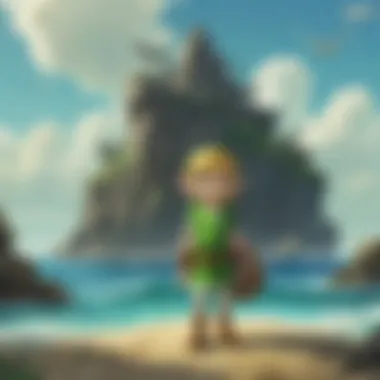
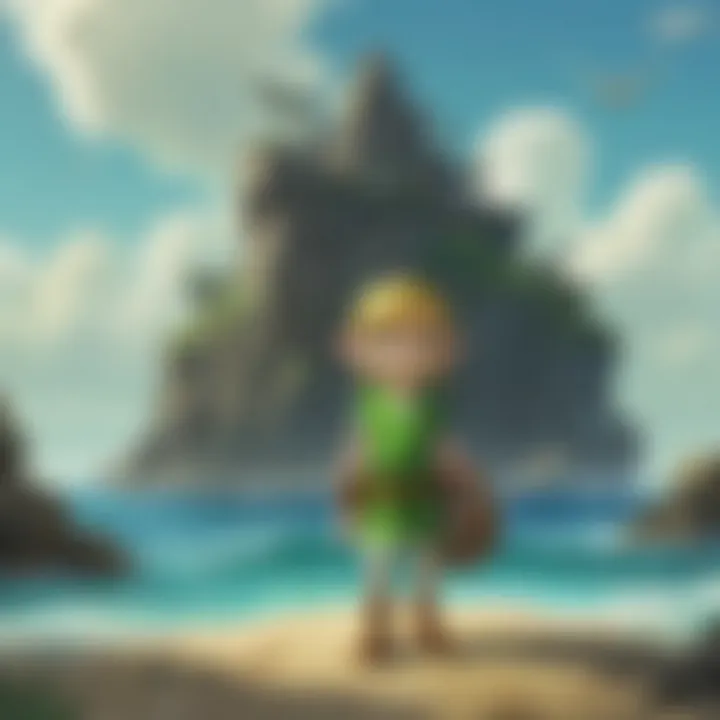
The atmosphere of any game is often shaped by its soundtrack and audio design, and The Legend of Zelda: Wind Waker is no exception. In this title, the audio serves as both a backdrop and a narrative device, enhancing emotional engagement while exploring the vast oceanic world. The music helps create memorable moments and breathes life into its characters, elevating the overall experience for players.
Musical Composition
In Wind Waker, the musical composition is a masterclass in utilizing melodies to reflect the game's themes. Composed largely by Kozue Ishikawa and Toru Minegishi, the soundtrack seamlessly blends orchestral elements with whimsical tunes that resonate with the game's adventurous spirit. The main theme, for instance, is instantly recognizable and conjures images of heroism and exploration.
Each piece of music is crafted to fit the various locales: gentle, flowing melodies accompany sailing on the seas, while tense orchestral scores heighten the stakes during battles. The decision to employ a more nautical and whimsical sound palette allowed the developers to differentiate Wind Waker from its predecessors, providing a fresh auditory experience.
"Listening to the Wind Waker soundtrack evokes a sense of nostalgia and adventure, capturing the essence of exploring new horizons."
Importantly, the musical motifs playfully echo throughout the game. For example, the Activation Theme gives players a sense of accomplishment when solving puzzles. Notably, during emotional scenes, the score takes center stage, inviting players to feel the weight of heroism and loss. The music not only complements the visuals but also helps weave the story, making the narrative more profound and impactful.
Sound Effects and Atmosphere
The sound effects in Wind Waker also deserve commendation for their role in crafting a captivating atmosphere. The gentle lap of waves against the boat, the creaking of the hull, and the vibrant sounds of island wildlife contribute to the immersion. Unlike many games that rely heavily on dialogue, Wind Waker opts for expressive sound effects, allowing for wordless storytelling.
Moreover, the use of audio cues helps guide players. For instance, specific sounds alert players to nearby treasure or dangers, fostering an intuitive connection to the environment. Similarly, the world is enriched by sound effects that change based on the setting—whether it's the echo in a cavern or the bustling sounds of a market. Each element is thoughtfully integrated, creating a layered soundscape that feels both alive and responsive.
The design choices in both musical composition and sound effects in Wind Waker profoundly contribute to the game's identity. The sound draws players into Link’s journey, serving as an emotional anchor. It's clear that sound in Wind Waker is not merely an accessory; it is an essential part in unfolding its legendary tale.
Comparative Analysis with Other Titles
Engaging in a comparative analysis of The Legend of Zelda: Wind Waker with other titles helps to highlight its unique contributions to the gaming landscape. This thoughtful examination aids in understanding how Wind Waker diverges from its predecessors and contemporaries, particularly focusing on its artistry, gameplay mechanics, and narrative structure. When looking at game development in an evolutionary context, one can see how each installment, including Wind Waker, builds upon or reinvents ideas from prior games in the franchise.
- Understanding Evolution: By comparing Wind Waker to other Zelda titles, particularly Ocarina of Time, enthusiasts can appreciate the development of gameplay mechanics, character depth, and storytelling techniques that have defined the series.
- Innovations and Improvements: Critical analysis of mechanics against the backdrop of earlier titles allows one to chart specific innovations that were introduced. This not only aids historians of gaming but also provides current developers with insight into success patterns.
- Cultural Reflection: Examining how a game like Wind Waker reflects or challenges cultural norms when juxtaposed with those in other games serves to better understand its legacy. These connections often mirror broader shifts in player expectations and creative boundaries.
Comparison with Ocarina of Time
The relationship between Wind Waker and Ocarina of Time is pivotal. Released years apart, each game reflects its time, yet their core designs tell a fascinating story of development. Ocarina of Time, celebrated for its 3D environments and pioneering mechanics, set the gold standard for action-adventure games.
Contrasts in Design: While Ocarina of Time favored a more realistic art style, Wind Waker embraced cel-shading, infusing the game with a vibrant aesthetic. This creative choice defined not just how players interacted with the world but also how they emotionally connected to it. The visual direction encouraged a lighter tone.
Gameplay Mechanics: The fluidity of z-targeting in Ocarina of Time was revolutionized, yet Wind Waker elevated exploration through its open-world design, placing wells of freedom at players’ fingertips. The shift in focus from linearity to a broader scope invited exploration at a much deeper level. Wind Waker’s sailing mechanics required players to navigate a vast ocean, enhancing the feeling of adventure in stark contrast to time-bound quests of Ocarina of Time.
Evolution of Zelda Mechanics
The evolution of mechanics in the Zelda franchise is best understood through the lens of player agency and world interaction. Starting from the rigid framework of earlier titles, Wind Waker represents a significant step toward richer gameplay experiences. The ability to manipulate the environment, voyage across expansive waters, and interact with non-linear quests marked a turn away from traditional game structures.
"Ultimately, Wind Waker not only carries the nostalgic weight of its predecessors but also shapes expectations for modern adventure titles."
- Non-linear Quests: Players often faced meaningful choices that branched narratives and shaped outcomes, a progression away from the one-size-fits-all paths in earlier games. This innovation provided each player a unique experience.
- Combat Systems: The combat evolved as well. Wind Waker introduced more dynamic swordplay, pairing timing with rhythm in combat scenarios, demanding a greater engagement from players.
- Environmental Interactivity: The ability to manipulate wind and water not only tied directly into core gameplay mechanics but also ensured that players felt like they truly influenced the game's world.
Cultural Impact and Legacy
The cultural impact and legacy of The Legend of Zelda: Wind Waker extend far beyond its release as a mere video game. It has become a touchstone in discussions surrounding innovation in game design and narrative storytelling. Not only did it redefine the Zelda franchise, but it also opened up dialogue about visual style and the importance of artistic expression in video games. These elements have become cornerstones not only for fans but for developers seeking inspiration.
Fan Community and Engagement
The fan community around Wind Waker is nothing short of vibrant. From the moment of its release, it sparked a love that transcended typical player engagement. People began sharing artwork, fan fiction, and theories regarding plot intricacies. There are countless forums, especially on platforms like Reddit, where long-time fans and newcomers gather to dissect the game, share their experiences, and create content.
- Fan Art: The distinct cel-shaded visuals inspired countless artists to recreate scenes and characters, showcasing their interpretations.
- Cosplay: Fans take their adoration to a new level through cosplay, dressing as Link, Tetra, and even the various pirates from the game.
- Speedruns: The engaging and open world has led to a thriving speedrunning community, where players challenge themselves to complete the game in the fastest time possible. Tactics and strategies are constantly being shared and refined.
So, it’s like a snowball effect; the initial love for the game snowballed into a massive community that thrives on collaboration and creativity. This added layer of engagement ensures Wind Waker remains relevant and continually celebrated.
Influences on Game Design
Wind Waker has influenced game design in numerous ways, essentially crafting a narrative about what video games could be. Its impact can be seen in:
- Cel-Shading as a Style: While Wind Waker popularized the cel-shading technique, it also influenced games like Jet Set Radio and Borderlands, which incorporate similar graphics to convey tone and style. This method created a unique visual identity that many developers now aspire to replicate.
- Open World Mechanics: The idea of free exploration in a grand seafaring adventure provided a template for many open-world games to follow. Titles like Breath of the Wild have taken these concepts even further, allowing players to experience adventures on their own terms.
- Narrative Depth: Storytelling aspects of Wind Waker, such as character development and the importance of choices, have inspired subsequent iterations of the Zelda franchise as well as other action-adventure games.
In summary, Wind Waker did not just add a chapter to gaming but rather wrote a new book that countless others would later draw inspiration from.
"While often seen as a departure from previous Zelda titles, it paved the way for future games by emphasizing art as much as gameplay."
Overall, the cultural impact and legacy of The Legend of Zelda: Wind Waker remains palpable. It serves as a vivid reminder of how video games can blend art, community, and design to create something that resonates with players long after its initial release.
Culmination
Reflecting upon The Legend of Zelda: Wind Waker, it's clear that this game holds a significant and unique place within the broader Zelda franchise. While it might not have initially received the accolades it deserved at launch, its legacy has only grown with time, cementing its status in gaming history.
Reflection on Wind Waker's Role in Zelda History
Wind Waker's importance can't be understated, especially when considering the daring artistic choices it presented. The shift to cel-shaded graphics marked a bold move away from the hyper-realistic trends dominating early 2000s titles, breathing new life into the Zelda series. Gamers who experienced the game upon its release often recall the initial skepticism, only to later embrace the sheer charm and vibrancy of its world.
This transition not only invigorated the franchise but also changed perceptions about what a Zelda game could be. The art style, elevated by the innovative use of cel-shading, carved a niche that influenced numerous titles. In fact, many new games still evoke the spirit of Wind Waker, underscoring its lasting impact.
Moreover, the gameplay mechanics—particularly the emphasis on exploration across vast seas—invited players to engage with the environment in a way that's both adventurous and relaxed. This nautical aspect introduced a sense of freedom, encouraging players to seek out hidden treasures and off-the-beaten-path islands, reinforcing the core themes of exploration and discovery.
"The Legend of Zelda: Wind Waker redefined how a story is conveyed through gameplay, intertwining player choices with narrative significance in delightful ways."
In terms of story, Wind Waker delves into themes of courage, legacy, and the eternal battle between light and darkness. Players encounter a richly woven tale that persists through generations, echoing the timeless motifs found throughout the earlier titles while also charting a new course for future adventures.
The community surrounding Wind Waker has also breathed life into its legacy. Enthusiasts dissect its intricacies on forums like reddit.com, where players continue to share discoveries, fan theories, and personal experiences. The game's fanbase, deeply passionate about its charm and character depth, showcases just how vibrant the cultural relevance of Wind Waker remains.







